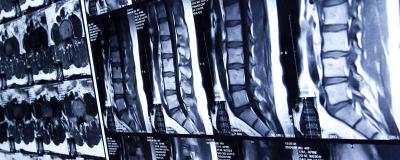Richard G. Fessler, MD, PhD, professor of neurosurgery and director of the Daniel F. and Ada L. Rice Laboratory for Regenerative Research, and Brian T. David, PhD, assistant professor of neurosurgery and research director, are continually researching ways to improve outcomes for people whose lives have been affected by demyelinating diseases, such as spinal cord injury (SCI) and multiple sclerosis. The new understandings they gain and the surgical techniques they refine are applied to treatments that have potential to improve people’s lives.
Testing 3D-printed scaffolds to reduce inflammation for improved SCI stem cell treatments
Dr. Fessler has been instrumental in the study and advancement of LCTOPC1 cells (derived from stem cells) for the treatment of SCI. When applied to the site of an SCI immediately after injury, these cells can help some patients efficiently regenerate myelin and regain some central nervous system function.
To help these cells more easily adhere to the spinal cord during transplantation and subvert inflammation after injury, Dr. Fessler and Dr. David have been working with a biomaterial company to characterize and devise 3D-printed and injectable biomaterial scaffolds. In an animal model, the scaffolds preserved spinal cord architecture without increasing inflammation following injury. The team completed preliminary immunohistological staining of tissue, and results suggested the scaffolds may also be sequestering inflammatory cells. This may buy physicians more time to target inflammatory cells with anti-inflammatory treatments. While the scaffolds have not yet been tested in humans, the lab continues to mount promising results.
Investigating the interconnectivity of inflammation after SCI
In addition to paralysis, SCI can lead to immune dysfunction and gut dysbiosis. The lab’s preliminary research confirms that acute treatment with stem cells can reduce the neuroinflammatory response after SCI, but it has minimal effect on the gut microbiome (the bacterial makeup of the digestive system).
Experiments continue to determine how to reduce inflammation throughout the body following SCI and how inflammation in one area of the body affects inflammation elsewhere. One of the lab’s medical students received a fellowship to advance this work over the summer, and a previous medical student published a review article on this topic in the Journal of Neurotrauma with Dr. Fessler and Dr. David.
Additionally, Dr. Fessler and Dr. David observed a significant correlation between the chronic spinal cord inflammatory response and the quality of cortical bone found in rodents’ hindlimbs after SCI. The lab is continuing experiments to see if this reduction in bone strength is driven more by spinal cord inflammation or disuse of limbs.
Determining the best window for therapeutic interventions
Dr. Fessler and Dr. David and their team have observed the neuroinflammatory response in mice post-SCI at various checkpoints. They were the first to characterize prolonged inflammation in two types of inflammatory cells — macrophages and T cells — and demonstrated that approximately 60 days post-injury to six months post-injury, levels of these cells persist well above those of uninjured animals. At six months post-injury, researchers see a significant correlation between immune cell infiltration and both an enlarged spleen and pain (hypersensitivity to thermal stimuli). This suggests that somewhere between seven- and 180-days post-injury, these inflammatory cells shift from a proinflammatory state to an anti-inflammatory state. This information can help researchers pinpoint the best window for therapeutic interventions.

